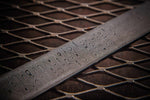
7 Things You Didn’t Know About Damascus Steel
7 Things You Didn’t Know About Damascus Steel
Damascus steel is legendary for its strength, beauty, and history — but there’s more to it than meets the eye. Here are seven surprising facts about this iconic metal that you might not know.
If the phrase “Damascus steel” means nothing to you, well, maybe it’s time that it should! Whether you know it or not, it’s likely you’ve used, purchased or held Damascus steel at some point in your life. That’s because this particular metal is extremely strong and created of the finest quality. While we’re on the subject, here are 7 things you need to know about Damascus steel.
It’s not really from Damascus
…but that doesn’t mean it doesn’t have a few ties to the area. This steel is known as “Damascus” because, in the third and fourth centuries (yes, it’s that old!), Western Europeans were introduced to the material when in the trading center of Damascus, which is now Syria. Since this is where the introduction formally occurred for many buyers, the name stuck – and continues to.
It’s actually from India
So where did Damascus steel actually originate? It came from India and the Middle East, although there are some historical instances reporting that some of the steel was produced in Damascus. That said, what we do know is that Asia and the Middle East are most likely to credit for this wondrous material.
It comes in waves
….kind of. What makes Damascus steel distinctive is the way in which it’s forged. The controlled mixture and physical manipulation of the iron and steel produce a unique, watery or “wavy” appearance. You’ll know Damascus steel when you see its signature unique patterns.
There’s a special variety
If you’ve heard the term, “wootz” in regard to steel, this refers to cast Damascus Steel, a labor-intensive product produced by melting pieces of iron and steel with charcoal in a reducing atmosphere (meaning that oxygen is reduced or eliminated). This results in the metal absorbing carbon from the charcoal and then cooled very slowly. This results in a visible, “crystalline” structure. When forged into the desired shape (like a sword, back in the day), the material lost the characteristic wavy appearance. But for the loss, a super strong, high-quality product is achieved.
But it’s easier than that
As the above process was so labor intensive, Westerners soon determined that they could produce a product similar to “wootz” with a lot less labor and cost. Fabricated Damascus steel, also known as pattern-welded steel, was much easier to make. This process involved “forge welding,” or essentially stacking two pieces of metal and hammering them together into one. Of course, the only way to do this is with metal that is near molten, so only sophisticated metal workers can achieve this. Because of the pounded layers, fabricated Damascus steel can also achieve the pattern characteristic of wootz.
It’s flexible too
The beauty of Damascus steel is that, beyond its beautiful appearance, it is both incredibly strong and extremely flexible. This unique combination has made Damascus steel the perfect alloy for creating strong and unbreakable swords, knives and other bladed weapons.
It may not be real
Because of its involved forging process and its quality and beauty, you’ll pay a premium for true Damascus steel. That said, not every wavy knife blade you see is truly Damascus steel. Be sure of the source when you’re buying a purported “Damascus steel” product. Because it’s so beautiful, this metal is often used today for everything from kitchen knives to wedding bands. That said, you need to do your research.
As one of the top producers of Damascus steel, we’re happy to see people appreciating this beautiful metal. Check out the beautiful patterns we’ve achieved in our forging process!